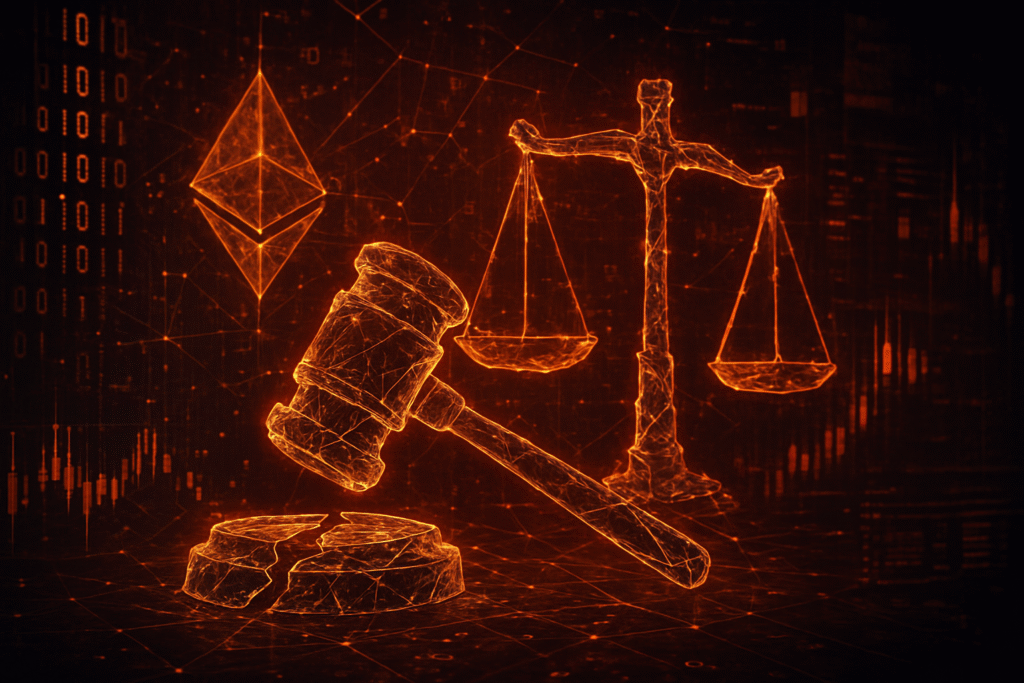
NEW YORK, NY – November 8, 2025 – In a development poised to send ripples through the cryptocurrency world, a mistrial was declared yesterday, November 7, 2025, in the high-profile case against brothers Anton and James Peraire-Bueno, accused of orchestrating a sophisticated $25 million cryptocurrency theft from the Ethereum blockchain. After three days of intense deliberation, a jury in the Southern District of New York was unable to reach a unanimous verdict, highlighting the immense complexities and legal ambiguities inherent in prosecuting alleged crimes within the nascent and often opaque digital asset landscape.
The case, which captivated legal and crypto communities alike, revolved around the contentious practice of Maximal Extractable Value (MEV) and the fine line between innovative, albeit aggressive, trading strategies and outright criminal activity. The prosecution argued that the MIT-educated brothers exploited a vulnerability in the Ethereum network in 2023, engaging in a "bait and switch" scheme to siphon funds. The defense, however, vehemently countered, asserting their clients' actions were merely a legitimate and highly technical trading maneuver within an unregulated market, likening it to "stealing a base in baseball." This deadlock underscores the profound challenge legal systems face in interpreting decentralized technologies and defining intent in a space where code is often law, and traditional legal frameworks struggle to keep pace. The immediate market reaction, while not yet fully crystallized, is likely to be one of uncertainty, as the crypto ecosystem grapples with the precedent—or lack thereof—set by this unresolved legal battle. The mistrial is a stark reminder of the urgent need for clearer regulatory guidelines and a deeper understanding of blockchain mechanics within the judiciary, as the industry matures and high-stakes legal confrontations become more frequent.
Market Impact and Price Action
The $25 million crypto theft in April 2023, while a significant technical exploit of the Ethereum blockchain's Maximal Extractable Value (MEV) ecosystem, did not trigger a dramatic, isolated market downturn for Ethereum (ETH) or the broader DeFi space at the time. The attack primarily targeted other automated trading bots rather than directly breaching core protocol security, and Flashbots, the developer of MEV-Boost, swiftly issued a fix. Consequently, the initial market reaction was largely contained, with the focus remaining on the technical intricacies of the exploit rather than widespread panic selling.
However, the mistrial declared on November 7, 2025, unfolded against a backdrop of considerable market volatility and several other high-impact events within the broader cryptocurrency ecosystem. On the day of the mistrial, Ethereum (ETH) experienced a noticeable dip, slipping below the $3,400 mark, representing a 2.91% decline within 24 hours. This was part of a larger bearish trend in early November, which saw ETH briefly touch a four-month low of $3,000, reflecting an over 12% drop. Despite this short-term price pressure, partially attributed to substantial whale selling, there was also significant whale accumulation, with large entities reportedly purchasing approximately $1.37 billion worth of ETH over a three-day period, signaling underlying confidence.
Adding to the nuanced picture, the Ethereum fund market premium surged to its highest level in 2025, indicating robust institutional investor interest and a long-term bullish outlook for ETH, with smart money seemingly capitalizing on discounted prices. ETH's trading volume on November 7, 2025, hovered around 736.25K, contributing to an overall crypto market 24-hour trading volume of $180.4 billion. While analysts projected a recovery for Ethereum, with forecasts suggesting an average close to November 2025 at $3,749.51 and potential highs of $4,500-$4,700 by late November, it's crucial to note that the mistrial itself did not appear to be the sole, or even primary, driver of these market movements. Instead, broader macroeconomic factors, significant whale activity, and other contemporaneous security incidents seem to have exerted a more dominant influence.
The period surrounding the mistrial was particularly tumultuous for the broader DeFi ecosystem, largely overshadowing any isolated impact from the Peraire-Bueno case. A major event was the catastrophic collapse of Stream Finance, an algorithmic stablecoin protocol, around November 7, 2025. This incident triggered a staggering $1 billion outflow of funds from yield-bearing stablecoins, marking the largest such outflow since the infamous Terra/UST crash in 2022. This collapse sent shockwaves through the DeFi space, leading to liquidations and spreading panic to other platforms such as Elixir Finance, Morpho, and Euler. Concurrently, an exploit in early November 2025 targeting Balancer, a prominent DeFi protocol, resulted in losses exceeding $100 million, further eroding investor confidence in protocol security. These systemic vulnerabilities and large-scale breaches had a far more profound and immediate market-wide impact on DeFi than the Peraire-Bueno theft or its subsequent mistrial. The Bybit hack in February 2025, which saw $1.4-$1.5 billion worth of ETH stolen, offers a relevant comparison; it caused an immediate 8% ETH price drop and $400 million in liquidations, demonstrating how direct, large-scale thefts can have acute market reactions, albeit often followed by rapid recovery due to swift exchange responses and community support.
Community and Ecosystem Response
The declaration of a mistrial in the $25 million crypto theft case has sent a clear signal across the cryptocurrency community, igniting fervent discussions and a renewed focus on the intricate legal landscape surrounding blockchain technology. On platforms like X (formerly Twitter) and Reddit, the news immediately sparked widespread debate, with a recurring sentiment that the mistrial effectively puts "code and value on trial." While Ethereum's social sentiment on X remains "mostly neutral" with a balanced mix of bullish, bearish, and neutral tweets, the sheer volume of engagement—over 430,000 tweets and nearly 25,000 Reddit posts mentioning Ethereum—underscores the community's keen interest in the implications of this legal impasse. The primary takeaway from these digital forums is the urgent need for clearer regulatory frameworks concerning Maximal Extractable Value (MEV) activities.
Crypto influencers and thought leaders, while not always issuing immediate, unified statements on the mistrial, have broadly reflected a growing concern about the legal ambiguities it exposed. There's a palpable tension between the desire to prevent illicit activities and the fear of stifling innovation within the decentralized finance (DeFi) space. Many advocates are warning against overly restrictive interpretations of existing fraud laws that could inadvertently hamper legitimate, albeit aggressive, algorithmic trading strategies. The Peraire-Bueno case has become a critical touchstone in this ongoing dialogue, pushing the conversation forward on how traditional legal systems can adapt to the novel and rapidly evolving world of blockchain exploits. The challenge of defining criminal intent in a system where transactions are immutable and often automated remains a central point of discussion among those shaping opinions in the crypto sphere.
While the direct, immediate effects on specific DeFi protocols, NFT projects, or Web3 applications are still being evaluated, the broader crypto market trends reflect a period of volatility and re-evaluation. Although Bitcoin and Ethereum Exchange-Traded Funds (ETFs) saw their first November inflows after a period of outflows, both assets continue to face challenges in the market. On November 7, Ethereum's price saw a modest 3.37% increase in 24 hours but a more significant 12.19% decrease over the past week, trading around £2,582.62 per ETH. Interestingly, Solana (SOL) spot ETFs recorded nine consecutive days of inflows, totaling $12.69 million on November 7, contrasting sharply with US Bitcoin spot ETFs which experienced $558 million in outflows on the same day. The overall crypto market capitalization also witnessed a decline, falling to $3.5 trillion from an October peak of $4.4 trillion. While this broader market downturn is influenced by numerous factors beyond the mistrial, the legal uncertainty surrounding MEV and other sophisticated blockchain interactions undoubtedly contributes to a cautious sentiment among investors and developers within the ecosystem. The mistrial has, therefore, become a potent symbol of the legal growing pains the industry is experiencing, prompting renewed calls for clarity and robust legal precedents to foster confidence and sustainable growth.
What's Next for Crypto
The mistrial in the $25 million crypto theft case marks a pivotal moment, injecting significant legal ambiguity into the very heart of the crypto market, particularly concerning Maximal Extractable Value (MEV) activities and the prosecution of complex blockchain-based crimes. This outcome starkly highlights the ongoing struggle of traditional legal systems to comprehend and adjudicate the nuances of decentralized, code-driven financial systems, and its repercussions are set to influence both short-term market dynamics and the long-term trajectory of crypto regulation.
In the short term, the immediate implication is increased uncertainty surrounding MEV activities. Without a clear legal precedent, both blockchain developers and regulators are left in a state of flux, potentially leading to hesitation or re-evaluation among projects deeply embedded in the MEV ecosystem. The mistrial also intensifies scrutiny on the "code is law" principle, a foundational tenet of decentralized networks, as the deadlocked jury leaves this fundamental debate unresolved. The Department of Justice's decision on whether to pursue a retrial will be a primary catalyst, as prolonging the legal battle would extend this period of uncertainty. For investors, this legal ambiguity translates directly into heightened risk, particularly for projects or transactions operating in these legally grey areas, potentially impacting market confidence and capital flows.
Looking further ahead, the long-term implications are geared towards an accelerated push for regulatory clarity. The mistrial serves as a potent reminder of the urgent need for "purpose-fit" crypto regulation that can effectively define fraud within decentralized systems and apply traditional laws to novel blockchain exploits. This will likely influence future protocol design, with platforms like Ethereum potentially accelerating efforts to implement MEV mitigation solutions, such as proposer-builder separation (PBS), to address exploitable gaps and reduce regulatory exposure. Moreover, the case will contribute to an ongoing jurisdictional competition, as countries strive to establish clearer and more attractive regulatory frameworks for crypto innovation, drawing lessons from pioneering efforts like Europe's MiCA. The continuous surge in crypto crime losses, with an estimated $3.6 billion stolen in the last year alone, further underscores the pressing need for robust and adaptable legal tools.
Several key catalysts and developments warrant close observation. Beyond the DOJ's decision on a retrial, new legislative proposals specifically addressing MEV and complex on-chain activities are highly anticipated, especially given the current U.S. administration's (presumably re-elected in 2024) "pro-crypto" stance, which could lead to more industry-friendly regulations. Judicial precedents from other high-profile crypto cases expected in 2025, particularly concerning securities law and administrative procedure, will collectively shape the broader legal landscape. Furthermore, technological advancements aimed at MEV mitigation within Ethereum's roadmap, such as Dencun upgrades, could offer technical solutions that pre-empt some regulatory concerns. For projects, strategic considerations must include proactive engagement with legal counsel, enhancing transparency in on-chain operations, exploring MEV-resistant designs, and active advocacy with policymakers. Investors, in turn, should prioritize enhanced due diligence, diversification, continuous monitoring of legal and regulatory updates, and a keen understanding of jurisdictional risks to navigate this evolving environment effectively. The most likely scenario is an increased regulatory push for tailored MEV regulations, with a strong possibility of the DOJ seeking a retrial to establish a clearer legal precedent, while the market's broader movements will continue to be influenced by macroeconomic factors and institutional adoption trends.
Bottom Line
The mistrial in the $25 million crypto theft case against Anton and James Peraire-Bueno, declared on November 7, 2025, serves as a profound inflection point for the cryptocurrency industry. It unequivocally highlights that the legal system is grappling with the fundamental question of what constitutes legitimate trading versus criminal theft in the complex, code-driven world of decentralized finance. For crypto investors and enthusiasts, the immediate key takeaway is the pervasive uncertainty surrounding Maximal Extractable Value (MEV) legality. The jury's inability to reach a unanimous verdict underscores that the line between a clever exploit and an illegal act remains blurred in the eyes of the law, challenging the long-held "code is law" principle. This signifies that regulatory risk is a high-priority consideration, necessitating due diligence that extends beyond technical whitepapers to encompass the potential legal interpretations of on-chain activities. The looming possibility of a retrial by the Department of Justice further prolongs this period of legal ambiguity.
In the long term, the mistrial's significance cannot be overstated. It guarantees lingering legal ambiguity for MEV, which could deter institutional involvement and innovation in this critical area of DeFi due to heightened legal risk. This outcome will intensify pressure on global regulators to develop clearer, purpose-fit frameworks for DeFi and MEV, balancing the need for fairness and consumer protection with the imperative not to stifle innovation. There's also a clear call for a re-evaluation of decentralization and individual responsibility, suggesting that merely operating within a permissionless framework may not fully absolve individuals of legal accountability for their on-chain actions. While this was a U.S. case, its unresolved nature will be closely watched globally, emphasizing the universal challenge in regulating digital assets. The mistrial also contributes to a broader "trust crisis" in DeFi, especially concerning manipulative trading practices, underscoring the urgent need for on-chain verification tools and regulatory clarity to combat misinformation and bolster retail investor confidence.
Ultimately, what this means for crypto adoption is a mixed bag. For institutional investors, the persistent legal uncertainty adds another layer of perceived risk, potentially slowing down broader institutional entry into the space. However, the intense scrutiny also heightens the need for robust protocol security and transparency. Projects that can effectively mitigate MEV-related exploits and clearly define acceptable behavior, perhaps through innovations like those outlined in Ethereum's Dencun roadmap, are likely to gain more trust. While the mistrial prolongs a contentious debate, it simultaneously forces a deeper public and legal understanding of the technical intricacies of blockchain operations like MEV. This increased awareness, even if born from conflict, is a necessary step towards more informed regulatory approaches and, eventually, more confident and widespread adoption.
To navigate this evolving landscape, several important dates, events, and metrics must be monitored. The most immediate is any announcement from the U.S. Department of Justice regarding a potential retrial. Beyond that, observe statements and rulemaking from regulatory bodies such as the U.S. SEC and CFTC, as well as international equivalents like the EU's MiCA, concerning MEV, market manipulation in DeFi, and the legal definition of digital asset ownership. Keep an eye on new legislative efforts, amicus briefs, and other legal challenges that seek to clarify MEV interpretation. Track developments in DeFi protocol upgrades (e.g., Ethereum's Dencun roadmap) aimed at mitigating MEV, alongside trends in institutional investment and Total Value Locked (TVL) in DeFi, which will serve as key indicators of market resilience and confidence amidst ongoing legal challenges.
This article is for informational purposes only and does not constitute financial or investment advice. Cryptocurrency investments carry significant risk.





